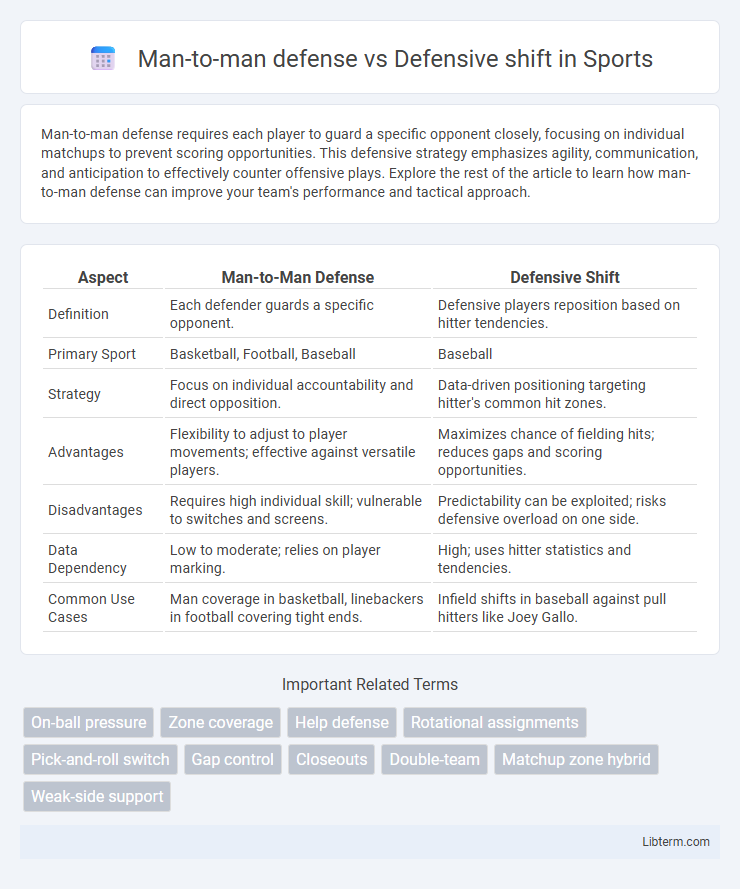Man-to-man defense requires each player to guard a specific opponent closely, focusing on individual matchups to prevent scoring opportunities. This defensive strategy emphasizes agility, communication, and anticipation to effectively counter offensive plays. Explore the rest of the article to learn how man-to-man defense can improve your team's performance and tactical approach.
Table of Comparison
| Aspect | Man-to-Man Defense | Defensive Shift |
|---|---|---|
| Definition | Each defender guards a specific opponent. | Defensive players reposition based on hitter tendencies. |
| Primary Sport | Basketball, Football, Baseball | Baseball |
| Strategy | Focus on individual accountability and direct opposition. | Data-driven positioning targeting hitter's common hit zones. |
| Advantages | Flexibility to adjust to player movements; effective against versatile players. | Maximizes chance of fielding hits; reduces gaps and scoring opportunities. |
| Disadvantages | Requires high individual skill; vulnerable to switches and screens. | Predictability can be exploited; risks defensive overload on one side. |
| Data Dependency | Low to moderate; relies on player marking. | High; uses hitter statistics and tendencies. |
| Common Use Cases | Man coverage in basketball, linebackers in football covering tight ends. | Infield shifts in baseball against pull hitters like Joey Gallo. |
Introduction to Man-to-Man Defense and Defensive Shift
Man-to-man defense requires each defender to guard a specific opponent closely, emphasizing individual accountability and quick reactions to offensive moves. Defensive shift involves repositioning players dynamically based on the opposing team's offensive setup, maximizing team coverage and adapting to offensive patterns. Both strategies aim to disrupt scoring opportunities but vary in execution, with man-to-man focusing on personal defense and shifts prioritizing overall spatial control.
Historical Evolution of Defensive Strategies
Man-to-man defense, a fundamental basketball strategy, originated in early 20th-century play, emphasizing individual player matchups to limit offensive scoring options. Defensive shifts emerged later, especially in the mid-20th century, reflecting a strategic adaptation where players reposition collectively to counteract offensive tendencies and exploit opponents' weaknesses. This evolution from rigid man-to-man assignments to dynamic team-based shifts marks a significant progression in defensive tactics, enhancing flexibility and responsiveness on the court.
Key Principles of Man-to-Man Defense
Man-to-man defense emphasizes individual accountability, where each defender is responsible for guarding a specific opponent, ensuring close pressure and limiting scoring opportunities. Key principles include maintaining proper positioning to deny passing lanes, effective communication to switch or help, and staying between the man and the basket to prevent easy drives. This defense relies on agility, anticipation, and disciplined footwork to adapt to offensive movements and create turnovers.
Fundamentals of the Defensive Shift
The fundamentals of the defensive shift rely on strategic player positioning based on batter tendencies and statistical data to enhance outfield and infield coverage. Unlike man-to-man defense, which assigns each defender to mark a specific opponent, the defensive shift reallocates defenders dynamically to areas with higher probability of batted balls. This approach maximizes the effectiveness of the defense by anticipating hitters' patterns and optimizing field coverage through advanced analytics.
Comparative Effectiveness in Modern Sports
Man-to-man defense offers individualized pressure and adaptability, providing tight coverage on offensive players and reducing passing lanes. Defensive shifts optimize team positioning by crowding high-probability scoring areas, enhancing zone control but sometimes sacrificing direct opponent matchup effectiveness. Modern sports analytics reveal that man-to-man defense excels in disrupting skilled ball handlers, while defensive shifts improve overall defensive efficiency by minimizing opponents' scoring opportunities in key zones.
Advantages and Disadvantages of Man-to-Man Defense
Man-to-man defense offers advantages such as personalized coverage, allowing defenders to closely guard specific opponents and react quickly to their movements, which enhances defensive pressure and reduces open scoring opportunities. However, this strategy can lead to mismatches if stronger offensive players exploit weaker defenders, increasing the risk of defensive breakdowns. The constant individual engagement also demands high stamina and communication, making the defense vulnerable to offensive cuts and screens if players lose focus or positioning.
Strengths and Weaknesses of the Defensive Shift
The Defensive Shift excels in disrupting hitter tendencies by positioning fielders strategically based on data-driven analysis, increasing the chances of outs in targeted areas. However, its weaknesses include vulnerability to hitters who can exploit gaps created by the shift or who adjust their approach, as well as potential communication breakdowns among fielders leading to errors. While the shift enhances infield defense efficiency, it may reduce coverage in traditional zones, allowing line drives or bunts to find open space more easily.
Impact on Player Performance and Team Dynamics
Man-to-man defense demands intense individual accountability, causing players to develop stronger one-on-one skills and defensive awareness, which enhances overall player performance. Defensive shifts, by contrast, optimize team positioning by aligning players strategically against opposing hitters' tendencies, improving collective response speed and reducing defensive errors. This strategic focus fosters seamless communication and cohesion, positively influencing team dynamics and efficiency on the field.
Tactical Adaptations and Hybrid Approaches
Man-to-man defense emphasizes individual accountability and direct matchup exploitation, allowing defenders to apply pressure and react swiftly to offensive actions. Defensive shifts strategically realign players based on opponent tendencies and situational cues, optimizing team coverage and anticipating plays. Hybrid approaches blend these tactics by assigning specific man-to-man roles within a flexible defensive framework, enhancing adaptability and unpredictability in various game scenarios.
Conclusion: Selecting the Best Defensive Strategy
Choosing the best defensive strategy depends on team strengths and opponent tendencies, with man-to-man defense excelling in tight, individual coverage and the defensive shift optimizing positioning against specific offensive plays. Man-to-man defense offers greater flexibility for disrupting player roles, while defensive shifting capitalizes on data-driven adjustments to counteract scoring patterns. Teams that integrate real-time analytics to decide between these approaches maximize defensive efficiency and adaptability.
Man-to-man defense Infographic

 libterm.com
libterm.com